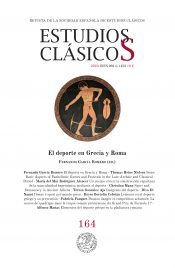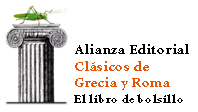Cayo Valerio Catulo: Entre la realidad y la ficciónCaius Valerius Catullus: between reality and fiction
AdminSandra
Resumen
La vida de Catulo oscila entre los rigores históricos y las suposiciones novelas. Por ello, nos proponemos contrastar las fuentes clásicas que tratan la vida y obra del poeta traspadano y confirmar aquellos hechos validados por la crítica clarificando elementos ampliamente discutidos por la comunidad científica. Junto a ello, presentaremos los ejemplos de ficción histórica en torno a la figura del poeta latino Catulo y sus fundamentación histórica.
Para la consecución de estos objetivos analizaremos las fuentes históricas más relevantes en el caso de nuestro poeta que hacen referencia a Catulo y Clodia como sucede en las obras clásicas sin olvidar, por supuesto, la propia obra de Catulo, los Carmina.
Al mismo tiempo que presentamos las fuentes historiográficas, daremos cuenta de una veintena de obras literarias del último siglo que imaginan y recrean la vida de Catulo, su contexto socio-político y su relación con Lesbia, ofreciendo un panorama general sobre la ficción histórica que propician estos personajes y el mundo grecolatino.
Por último, también haremos referencia a los filmes en las que nuestro autor aparece como un personaje de ficción más dentro de una película histórica, convirtiéndolo, por fin, en un constructo histórico del género.
Palabras clave:
Abstract
The Catullus’ life oscillates between the historical rigors and the novel assumptions. For this reason, we propose to contrast the classical sources that deal with the life and work of the pierced poet and confirm those facts validated by critics, clarifying elements widely discussed by the scientific community. Along with this, we will present the examples of historical fiction around the figure of the Latin poet Catullus and its historical foundations.
To achieve these objectives, we will analyze the most relevant historical sources in the case of our poet that refer to Catullus and Clodia as happens in the classic works, without forgetting, of course, Catullus’s own work, the Carmina.
At the same time that we present the historiographic sources, we will give an account of some twenty literary works of the last century that imagine and recreate the life of Catullus, his socio-political context and his relationship with Lesbia, offering an overview of the historical fiction that they promote these characters and the Greco-Latin world.
Finally, we will also refer to films in which our author appears as one more fictional character within a historical film, finally turning him into a historical construct of the genre.
Keywords:
Referencias bibliográficas
Barceló, I. (2013). La muchacha de Catulo. Madrid: Ediciones Evohé.
Benton, K. (1974). Death on the Appian Way. Londres: Chatto & Windus.
Berjano Rodríguez, B. (2020). “Clodia Metela en el discurso ‘Pro Caelio’ de Cicerón: un arquetipo subversivo de mujer”. Journal of Feminism, Gender and Women Studies, 8, pp. 3-11.
Butler, H. E., Towned, G. (2013) [ed.]. Suetonius: Divus Julius. Londres: Bloomsbury 3PL.
Chapelle, M. de la (1707). The Adventures of Catullus. Woodbridge: Reasearch Publications.
Cirilo de Melo, W. D. (2019) [ed.]. Varro: De Lingua Latina. Oxford: Oxford Classical Texts.
Clark, A. (1963) [ed.]. Cicero Orationes. Vol. I. Oxford: Oxford Classical Texts.
Damon, C. (2021). “Situating Catullus”. En Ian du Quesnay, Tony Woodman (eds.). The Cambridge Companion to Catullus. Cambridge: Cambridge University Press, pp. 7-25.
Davey, R. (1888). Lesbia. (obra de teatro) Londres: Lyceum Theatre
Dayton, E. L. (1982). Chantefable: The Story of The Roman Poet Catullus and his Love for Lesbia. Spring: Gardnor House.
DeMaria, R. (1965). Clodia. Nueva York: St. Martin’s.
Dixon, P.J. (1953). Farewell Catullus. Londres: Hollis & Carter.
Dixon, S. (2001). Reading Roman Women: Sources, Genres and Real Life. London: Duckworth.
Donalson, M. A. (1996). A translation of Jerome’s Chronicon with Historical Commentary. Lewiston: Edwin.
Dunmore, H. (2008). Counting the Stars. Londres: Fig Tree, Penguin Books.
Fernández Corte, J.C.; González Iglesias, J.A. (2004). [intr., ed. y com.]. Catulo. Poesías. Madrid: Cátedra.
Gamo, A. (2004). [intr. y com.]. Catulo. Poesías completas. Madrid: Aache Ediciones.
García Gual, C. (1995). La Antigüedad novelada y la ficción histórica: Las novelas históricas sobre el mundo griego y romano. Madrid: Fondo de Cultura Económica de España SL.
Hardy, W.G. (1957). The City of Libertines. Nueva York: Popular Library.
Harris, R. (2005). Lustrum. Conwy: Arrow Editorial.
Hartz, C. (2008). Excrucior. Darmstadt: Verlag Phillip von Zabern.
Holder, A. (1967) [ed.]. Pomponi Porfyrionis Commentum in Horatium Flaccum. Hildersheim: Olms.
Holland, T. (1995). Attis. Londres: Allison & Busby.
Jackson, A. (2003). Catullus for Children. Auckland: Auckland University Press.
Jackson, A. (2014). I, Clodia, and other portraits. Auckland: Auckland University Press.
Jackson, A. (2019). “Clodia through the looking glass”. En Marguerite Johnson (ed.) Antipodean Antiquities. Classical Reception Down Under. Londres: Bloomsbury, pp. 117-130.
Jaro, B.K. (2002). The Key. Nueva York: Dodd, Mead.
Keil, H. (1857). Gramatici Latini. Stuttgart: Teubner.
Kenney, J. (1994) [ed.]. Ovid Amores, Medicamina Faciei Feminae, Ars Amatoria, Remedia Amoris. Oxford: Oxford Classical Texts.
Lachmann, K. (1874). Q. Valerii Catulli Veronensis Liber. Berlin: typis et imprensis Ge. Reimeri.
Lillo Redonet, F. (2003). “Virgilio y Catulo en el cine y la televisión”. Cuadernos de Filología Clásica. Estudios Latinos. 23.2, pp. 437-452.
Lindsay, J. (1934). Rome for sale. Londres: Elkin Mathews and Marrot Limited.
Lovric, M. Gurguí, M, Sabaté, H. [trad.] (2007). El libro flotante. Barcelona: Verticales de Bolsillo.
Maas, P. (1942). “The Chronology of the Poems of Catullus”. Classical Quarterly 36, pp. 79-82.
Maddox Roberts, J. (1991). SPQR II: The Catiline Conspiracy. Nueva York: St. Martin’s.
Magnaldi, G. (2019) [ed.]. Apuleius Philosophical works. Apulei Opera Philosophica. Oxford: Oxford Classical Texts.
Mankiewicz, J. L. [guionista y director] (1963). Cleopatra. [película]. Estados Unidos: Twentieth Century Fox Film Corporation.
Mynors, R.A.B. (1958) [ed.]. C. Valerii Catulli. Carmina. Oxford: E Typographeo Clarendoniano.
Neff, R. (2016). Loving Well: Keys to Lasting and Rewarding Relationships. Morrisville: Lulu Publishing Services.
O’Hagan, J. (1988). A Roman Death. Nueva York: Doubleday.
Olimpi, A. (2021). Clodia: Fabula Criminalis: A latin Novella. Michigan: Independen Publisher.
Owen, S. G. (1915) [ed.]. P. Ovidi Nasonis: Tristium Libri Quinque; Ibis; Ex Ponto Libri Quattuor; Halieutica Fragmenta. Oxford: Oxford Classical Texts.
Priante, A. (1992). Lesbía mía. Barcelona: Seix Barral.
Quinn, K. (1972). Catullus. An Interpretation. Londres: B.T. Batsford Ldt.
Rackham, H., Jones, W. H. S., Eichholz, D. E. (1938-1962) [ed.]. Pliny – Natural History, 10 volumes. Harvard: Loeb Classical Library.
Roebuck, R. (1991) [ed.]. Nepos: Three Lives: Alcibiades, Dion and Atticus. Londres: Bloomsbury 3PL.
Salkey, A. (1969). The Adventures of Catullus Kelly. Londres: Hutchinson.
Saylor, S. García de la Hoz, M.L., Ayuso, R. [trad.] (1995). La suerte de Venus. Barcelona: Emecé Editores.
Saylor, S., García de la Hoz, M. L. [trad.] (1996). Asesinato en la Vía Apia. Barcelona: Emecé Editores.
Schwob, M., Novo Presa, O. [trad.] (1896). Vidas imaginarias. Oviedo: Krk Ediciones.
Sciolla, L., Ciurans Ferrándiz, A. [trad.] (2013). Mil besos y cien más. Barcelona: Debols!llo.
Skinner, M.B. (2011). Clodia Metelli: The Tribune’s Sister. Oxford: Oxford University Press.
Soler, A. (1993) [intr. trad. y notas]. Catulo. Poemas. Tibulo. Elegías. Madrid: Gredos.
Stead, H. (2016). A Cockey Catullus. The Reception of Catullus in Romantic Britain, 1795-1821. Oxford: Oxford University Press.
Theodorakopoulos, E. (2013). “Catullus and Lesbia Translated in Women’s Historical Novels”. En Lorna Hardwick, Stephen Harrison, S. J. Harrison [eds.]. Classics in the Modern World: A Democratic Turn?. Oxford: Oxford University Press, pp. 275-286.
Thomson, D.F.S. (2015) [intr., ed. y com.]. Catullus. Toronto: University of Toronto Press. (=1997)
Wheeler, A.L. (1934). Catullus and the Traditions of Ancient Poetry. Berkeley: University of California Press (=1974).
Wilder, T. Martínez Sierra, M. [trad.] (1948). Los idus de marzo. Barcelona: RBA Promociones Editoriales.
Wilkins, A. S. (1963) [ed.]. Cicero Rhetorica. Vol. II. Oxford: Oxford Classical Texts.
Wiseman, T.P. (1969). Catullan Questions. Leicester: University Leicester.
Wiseman, T.P. (1985). Catullus and his World: A Reappraisal. Cambridge: Cambridge University Press.
Wiseman, T.P. (2007). “The Collection (1979)”. En J. Haig Gaisser (ed.). Catullus. Oxford: Oxford University Press, pp. 66-76.
Wiseman, T.P. (2011). “The Valerii Catulli of Verona” En M. B. Skinner (ed.). A companion to Catullus. Londres: Wiley-Blackwell, pp. 57-71.
Ziolokowsi, T. (2007). “Anglo-American Catullus since the Mid-Twentieth Century”. International Journal of the Classical Tradition 13.3 (winter), pp. 409-430.
Ziolokowsi, T. (2020). Roman Poets in Modern Guise. The reception of Roman Poetry since World War I. Nueva York: Camdem House.
Revista
-
Sobre la revista
Página principal
-
Estatutos
Estatutos de la Revista Estudios Clásicos
-
Código ético
Declaración de buenas prácticas
-
Normas de recepción y envío
Indicaciones para envíos de artículos
-
Equipo editorial
Consejos de redacción y asesor
-
Comité de honor
Comité de honor
Información
-
Para autores
Publicar con nosotros
-
Para evaluadores
Normas para evaluar artículos
-
Para bibliotecas
Información bibliográfica
-
Contacto
Cuestiones y preguntas
Publicar en EClás
-
Envío de originales
Artículos y reseñas
-
Normas de publicación
Descarga normas en PDF
-
Estilo CSL EClás
Estilo CSL EClás
-
Índices de calidad
Bases de datos e impactos


 c/ Serrano, 107
c/ Serrano, 107